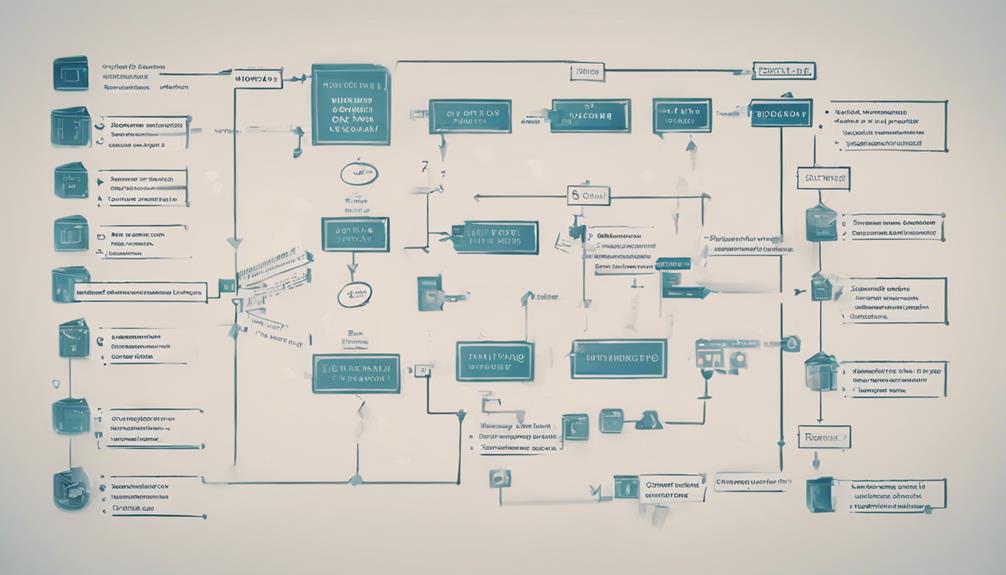To train staff for order processing services, did you know that incorporating real-life scenarios and interactive exercises can significantly boost their learning retention? By immersing employees in hands-on experiences that mirror actual order processing situations, you can effectively enhance their skills and decision-making abilities. Stay tuned to discover more insightful strategies that can take your staff training to the next level and ensure optimal performance in order processing services.
Identify Training Needs
To effectively prepare your staff for order processing services, you must first identify their training needs through a comprehensive assessment process. This involves conducting a thorough training assessment and skill gap analysis to determine the areas where your team requires improvement. By analyzing performance metrics and establishing a feedback loop, you can gather valuable insights into the strengths and weaknesses of your staff members. Performance metrics such as order processing accuracy rates, average handling times, and customer satisfaction scores can help pinpoint specific areas that need attention.
Through a detailed skill gap analysis, you can identify the specific skills and knowledge gaps that exist within your team. This will enable you to tailor your training program to address these gaps effectively. By establishing a feedback loop that includes regular performance evaluations and opportunities for staff to provide input on their training needs, you can ensure that your training program remains relevant and impactful. This proactive approach to identifying training needs will set the foundation for a successful order processing service training program.
Develop Training Program
Begin crafting your training program by outlining clear learning objectives and designing engaging training materials that cater to the specific needs identified during the skill gap analysis process. Conduct a thorough training assessment to determine the current skills and knowledge levels of your staff. This will help you tailor the training program to address any gaps effectively.
To ensure the success of your training program, encourage team collaboration by incorporating group activities and discussions into the training sessions. This will not only foster a sense of teamwork but also provide opportunities for your staff to learn from each other’s experiences and best practices.
Consider utilizing various training methods such as hands-on simulations, role-playing exercises, and interactive presentations to keep the training sessions engaging and informative. Incorporating feedback mechanisms throughout the training program will allow you to continuously assess its effectiveness and make necessary adjustments. Remember, a well-designed training program supported by team collaboration can significantly enhance the skills and performance of your staff in order processing services.
Schedule Training Sessions
To effectively schedule training sessions for order processing services, start by setting clear objectives for each session. Ensure that all necessary training materials are prepared and readily available before each training session. By establishing these foundations, you can maximize the efficiency and effectiveness of your staff training program.
Set Clear Objectives
Establishing clear objectives for training sessions is crucial for effectively preparing staff for order processing services. Before scheduling any training, it’s essential to conduct a performance evaluation and skill assessment of your team. This evaluation will help you identify areas where employees may need improvement and allow you to tailor the training goals to address these specific needs.
When setting training goals, it’s important to ensure they are measurable outcomes. For order processing services, objectives like reducing order errors by a certain percentage, increasing order processing speed, or improving customer satisfaction ratings can be valuable goals to work towards. By clearly defining these objectives, you provide your staff with a clear understanding of what is expected of them during the training sessions.
Setting clear objectives not only gives your training sessions structure but also helps in evaluating their effectiveness post-training. Regularly reviewing these objectives and measuring them against the performance improvements of your staff will enable you to refine your training approach and continuously enhance the order processing services provided.
Establish Training Materials
When preparing to schedule training sessions for order processing services, it is essential to gather and establish the necessary training materials. Begin by compiling detailed manuals, guides, and any relevant documentation that will aid in the training process. These materials should cover various training techniques to ensure staff members are equipped with the skills needed for efficient order processing. Additionally, consider incorporating assessments within the training materials to continuously assess the effectiveness of the training sessions.
As you plan the training delivery, allocate resources effectively to support the training process. This includes setting up training sessions in a conducive environment, providing access to necessary tools and software, and scheduling regular follow-up sessions to reinforce learning. By strategically organizing and utilizing training materials, you can enhance the overall effectiveness of the training program for order processing services. Remember, the key is to assess the effectiveness of the training techniques and make adjustments as needed to ensure optimal results.
Conduct Training
When conducting training for order processing services, ensure that staff receive role-specific task training tailored to their responsibilities. Implement hands-on practice sessions to reinforce learning and improve skill retention. Continuously develop staff skills to adapt to changing demands and enhance overall efficiency.
Role-Specific Task Training
During the training sessions for order processing services, ensure that each staff member receives role-specific task training to enhance their efficiency and accuracy in carrying out their responsibilities. Task delegation plays a crucial role in this training process, allowing employees to understand their individual duties within the order processing workflow. Job shadowing can also be beneficial, as it provides new team members with firsthand experience and insights into how tasks are performed by seasoned staff.
Incorporating simulation exercises and role-playing scenarios can further deepen staff understanding of their roles. These activities offer a practical approach to learning, allowing employees to apply their knowledge in a controlled environment. Through simulations, employees can practice handling different order processing scenarios, improving their decision-making skills and familiarity with the systems and processes involved.
Hands-On Practice Sessions
To effectively conduct training for hands-on practice sessions in order processing services, it is essential to provide a structured environment that allows staff to apply their knowledge and skills in realistic scenarios. Incorporating simulation exercises and real-world scenarios into the training sessions can significantly enhance the staff’s understanding of order processing procedures. Practical application is key during these hands-on practice sessions, where employees can interact with the system and practice entering orders, processing payments, and managing customer inquiries.
Interactive training methods such as role-playing exercises can help employees develop their problem-solving skills and improve their ability to handle various order processing situations. By creating a dynamic and engaging learning environment, staff members can actively participate in the training process and gain valuable experience that they can apply in their day-to-day tasks.
Continuous Skill Development
Invest in ongoing training programs to facilitate continuous skill development for your staff involved in order processing services. Continuous skill development is crucial to enhance efficiency and maintain high-quality standards in order processing. Here are some key strategies to consider:
- Regular Team Collaboration: Encourage regular team meetings and brainstorming sessions to foster collaboration among staff members. This can help employees learn from each other, share best practices, and improve overall performance.
- Time Management Workshops: Conduct workshops or training sessions focused on effective time management techniques. Providing employees with tools and strategies to prioritize tasks and manage their time efficiently can significantly boost productivity.
- Skill Enhancement Modules: Offer skill enhancement modules or courses that are relevant to order processing services. This could include training on new software, communication skills, or problem-solving techniques to equip staff with the necessary skills to excel in their roles.
Provide Support
Offering comprehensive support to staff is essential for ensuring efficient order processing services. Team collaboration plays a crucial role in providing support by encouraging employees to work together, share knowledge, and solve problems collectively. Foster an environment where team members can communicate openly, offer assistance, and collaborate on finding innovative solutions to enhance order processing efficiency.
Employee engagement is another key aspect of providing support. Engaged employees are more likely to be motivated, productive, and committed to delivering high-quality order processing services. Encourage employee engagement through regular feedback sessions, recognition of achievements, and opportunities for skill development. By creating a supportive and engaging work environment, staff members are more likely to feel valued, motivated, and empowered to excel in their roles.
Incorporate regular team meetings, training sessions, and mentorship programs to promote team collaboration and employee engagement. By providing ongoing support and fostering a culture of teamwork and engagement, you can enhance the overall effectiveness of your order processing services.
Monitor Progress
Regularly tracking and assessing the progress of your staff in order processing services is crucial for identifying areas of improvement and ensuring operational efficiency. To effectively monitor progress and enhance staff performance, consider the following strategies:
- Performance Tracking: Implement a system to track individual and team performance metrics regularly.
- Feedback Strategies: Provide constructive feedback to employees based on their performance evaluations, highlighting both strengths and areas for development.
- Motivation Techniques: Utilize various motivational techniques such as recognition programs, incentives, and rewards to keep staff engaged and motivated.
Evaluate Performance
Utilize a comprehensive performance evaluation system to assess the efficiency and effectiveness of your staff in order processing services. Conduct regular performance reviews to provide constructive feedback on individual performance. These reviews should focus on key metrics such as order accuracy, processing speed, and customer satisfaction. Offer specific examples to illustrate areas of strength and areas needing improvement.
Performance reviews serve as a foundation for performance improvement and motivation. Use these evaluations not only to identify areas for growth but also to recognize and reward outstanding performance. By providing clear and actionable feedback, you can empower your staff to enhance their skills and excel in their roles. Encourage open communication during performance reviews to address any concerns or challenges that may be hindering productivity.
Furthermore, tie performance evaluations to opportunities for professional development and advancement within the organization. Establishing a clear link between performance and career progression can motivate employees to strive for excellence in their order processing responsibilities.
Frequently Asked Questions
How Can Staff Handle Difficult Customers During Order Processing?
When handling difficult customers during order processing, remember to stay calm and empathetic. Use conflict resolution techniques like active listening and problem-solving. Managing high-pressure situations calls for quick thinking and effective customer service strategies.
What Software Tools Are Recommended for Efficient Order Processing?
When it comes to efficient order processing, utilizing order processing automation tools is key. These software solutions help streamline workflows, making the entire process more organized and productive for your team.
Are There Any Tips for Improving Order Accuracy and Speed?
To boost order accuracy and speed, prioritize time management for efficient task handling. Enhance communication skills to clarify orders promptly. These strategies streamline processes, ensuring orders are processed accurately and swiftly.
How Can Staff Stay Motivated During Repetitive Order Processing Tasks?
When facing repetitive tasks, remember the power of teamwork. Engage in team building activities to foster camaraderie. Offer incentives like bonuses or rewards for exceptional performance. Ensure staff feel valued through consistent recognition and performance tracking.
What Measures Can Be Taken to Prevent Order Processing Errors?
To prevent order processing errors, you can implement double-checking procedures, provide thorough training on software usage, and establish clear communication channels with customers. These error prevention strategies and customer communication techniques enhance accuracy and service quality.



